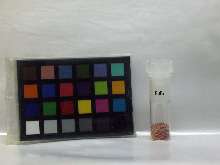Plutonium tetrafluoride
Plutonium(IV) fluoride is a chemical compound with the formula (PuF4). Like all plutonium compounds, for signatories to the treaty, plutonium tetrafluoride is subject to declaration and control under the Nuclear Non-Proliferation Treaty through agreements with the International Atomic Energy Agency.[2]
-fluorid.png) | |
| Names | |
|---|---|
| IUPAC name
Plutonium(IV) fluoride | |
| Other names
Plutonium tetrafluoride | |
| Identifiers | |
| ChemSpider | |
PubChem CID |
|
CompTox Dashboard (EPA) |
|
| |
| Properties | |
| PuF4 | |
| Molar mass | 320 g/mol |
| Appearance | reddish-brown monoclinic crystals |
| Density | 7.1 g/cm3 |
| Melting point | 1,027 °C (1,881 °F; 1,300 K) |
| Structure | |
| Monoclinic, mS60 | |
| C12/c1, No. 15 | |
Except where otherwise noted, data are given for materials in their standard state (at 25 °C [77 °F], 100 kPa). | |
| Infobox references | |
There are multiple reaction paths for producing plutonium metal from PuF4 including reacting plutonium tetrafluoride with barium, calcium, or lithium at 1200 °C:[3][4][5]
- PuF4 + 2 Ba → 2 BaF2 + Pu
- PuF4 + 2 Ca → 2 CaF2 + Pu
- PuF4 + 4 Li → 4 LiF + Pu

Plutonium tetrafluoride can appear a variety of colors depending on the grain size, purity, moisture content, lighting, and presence of contaminants.[4][5] Its primary use in the United States has been as an intermediary product in the production of plutonium metal for nuclear weapons usage.[3]
References
- Lide, David R. (1998), Handbook of Chemistry and Physics (87 ed.), Boca Raton, Florida: CRC Press, pp. 4–76, ISBN 0-8493-0594-2
- "Key Roles". www.iaea.org. 2014-07-11. Retrieved 2019-05-24.
- United States Department of Energy (1997). Linking Legacies: Connecting the Cold War Nuclear Weapons Production Processes to Their Environmental Consequences (PDF). Washington D.C.: United States Department of Energy. pp. 184, passim.
- Baldwin, Charles E.; Navratil, James D. (1983-05-19). "Plutonium Process Chemistry at Rocky Flats". In Carnall, William T.; Choppin, Gregory R. (eds.). Plutonium Chemistry. ACS Symposium Series. 216. AMERICAN CHEMICAL SOCIETY. pp. 369–380. doi:10.1021/bk-1983-0216.ch024. ISBN 9780841207721.
- Christensen, Eldon L.; Grey, Leonard W.; Navratil, James D.; Schulz, Wallace W. (1983-05-19). "Present Status and Future Directions of Plutonium Process Chemistry". In Carnall, William T.; Choppin, Gregory R. (eds.). Plutonium Chemistry. ACS Symposium Series. 216. AMERICAN CHEMICAL SOCIETY. pp. 349–368. doi:10.1021/bk-1983-0216.ch023. ISBN 9780841207721.
- Pfeiffer, Martin (March 3, 2019). "PuF4 Pics ORO 2019 00475-FN Final Response 20190312_Page_07_Image_0001". Pfeiffer Nuclear Weapon and National Security Archive. Retrieved May 23, 2019.
- Pfeiffer, Martin (March 3, 2019). "FOI 2019-00371.Loaded powder pan at RMC line". Pfeiffer Nuclear Weapon and National Security Archive. Retrieved May 23, 2019.
.jpg)